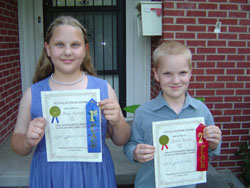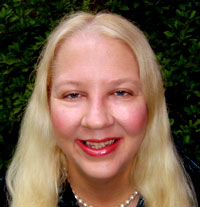How to Run a Super Story Contest for Your Group
By Linda Burklin
Printed in Practical Homeschooling #68, 2005.
 Speaking of improved writing—this mom's figured out exactly how to run a story contest that makes children of all ages want to write!
Speaking of improved writing—this mom's figured out exactly how to run a story contest that makes children of all ages want to write!

|
 |
Speaking of improved writing-this mom's figured out exactly how to run a story contest that makes children of all ages want to write!
When I finally joined a home school group (after home schooling "by myself" for eight years), I wondered why there didn't seem to be any activities to encourage children in their creative writing endeavors. After a couple of years the answer dawned on me: there wasn't any outlet for creative writing because I had not established one.
Once I got over the hump of waiting for someone else to come up with an idea, I was off and running. I announced our first annual Story Contest. To put everyone on an equal footing, I gave them the first sentence of the story, and divided the entries into three age groups, from fourth grade through high school.
This first contest was such a success that the next year I added a poem contest as well.
One of the things I've learned during the last four years is that running a story and poem contest (and publishing the resulting book) is a lot of work-but it's very rewarding work. If you are interested in organizing a story and poem contest for your group, maybe my experiences will be of interest to you.
One of the first things I realized was that I would not be able to do the judging myself, as I had originally planned. After all, I wanted my own children to enter-in fact I required them to enter-so I could hardly be an impartial judge! Fortunately, I have a dear friend who is a published writer with a degree in journalism. She also happens to love children, so that problem was solved quite easily. (She is not a homeschooler and is not associated with our group in any way.) She happily sits down for several hours each year, reading and rereading stories as she makes her decisions. (Note: the first year I tried having two judges, but regretted it because they disagreed on virtually everything!)
The next challenge was devising rules to keep everyone on an equal footing and to ensure anonymity till after the judging was complete. My rules are very specific and have become more so as I have gained experience. From the beginning each age group has had a lower and upper word limit. We all know there are some boys who would turn in a 50-word story if allowed, and some girls who would turn in a full-length novel! Elementary stories (grades 4-6) must be at least 500 words but no more than 1,000. Junior high stories (grades 7-9) must be at least 800 words but no more than 1,800. Senior high stories (grades 10-12) must be at least 1,000 words but may not be longer than 2,500.

Flynn reads his prize-winning story about his alter ego, Arthur Dangerfield. For four straight years he managed to write about Arthur, no matter what the story starter was! |
There must be at least three entries in each age group in order for that group to be judged, so there have been times when I have had to re-engineer the age groupings. I always have plenty of elementary entries, but not very many high school entries, so I may bump ninth grade up into the senior high category if I don't have enough stories from students in grades 10-12. (No one may enter more than one story and one poem.)
My story starter is just 1-2 sentences long, It has ranged from wide open ("When I opened the door this morning I couldn't believe my eyes!"), to nautical, to mysterious, to science fiction. The rules state that the story must begin with the opener, and it must be an integral part of the story (i.e., it can't be a dream or something the narrator is watching, listening to, or reading). We had to make this rule after one student explained the starter as a passage in a book, then took off in a completely different direction!
For poems I wouldn't presume to impose a starter, but I do give a different theme each year. Part of the judging concerns how well each poem deals with the theme. Past themes have included God's creation, description of a particular person, and joy.
Each story and poem must be typed on a computer (preferably in Microsoft Word) in a specific font and size. The student's name must not appear anywhere on the document; instead, each submission must have a title. Each story or poem is put into a plain manila envelope with only the grade of the student and the genre written on the outside (e.g,. 7th Grade Story). Inside the envelope, along with the anonymous story, is a smaller sealed envelope which has the title of the story on the outside. Inside this inner envelope is a card containing the student's name and contact information. The smaller envelope must also contain either a disk holding the story document or a note explaining that the parent will email me the story after judging is complete.
I announce the contest and start sign-ups three months before the deadline, to give kids plenty of time to think and write. Parents may not contribute in any way except to correct spelling and punctuation.
On deadline day, we put a box out on our porch so that stories and poems can be dropped off anonymously.
Then comes the most fun part for me. I sort the manila envelopes into age groups and categories, open them, and start reading! I get such a kick out of reading the different stories and poems and seeing what amazing imaginations these kids have. For instance, I would never have thought of using a bungee cord to escape from an exploding planet. Or having a planet that could change size with the flip of a lever!

Mercy and Spencer display their Story Contest ribbons and certificates. They came in first and second this year. |
On "judgment day" I take all the manila envelopes to my meeting with the judge and let her do her work. As she comments on each story, I take notes, which I later type up and return to the contestants along with their stories. Once the judge has made all her decisions, I note them all down, thank her for all her hard work, and open up the little envelopes to find out who wrote all those creative stories and poems. Then I head home to start the biggest job of all.
A unique feature of our story and poem contest is that all the stories and poems are put together into a book, thus making it possible for all the contestants to read everyone else's entries. Extra copies of the book may be ordered and paid for in advance. The job of editing and producing the book is very time-consuming, but the book is also what most kids like best about the contest. They love seeing their names and their stories or poems in print, and they also love to read all the other stories and poems. My own children read and reread their books each year and always pester me to let them have a sneak peek at the contents (naturally, I refuse). In four years, the book has grown from ten stories and 21 pages to 24 stories, 8 poems, and 92 pages.
I use any disks that have been submitted to begin my book document, and the rest of the stories come in by email so I can just cut and paste them into the appropriate place. I insert the authors' names and then start the laborious process of editing. I correct all typos and spelling errors, and correct punctuation as well. I find I spend a lot of time inserting quotation marks! Once I have edited all the stories and arranged them in some kind of order, I make up the table of contents and the cover page. This year for the first time we had a full-color cover-a big step up for us.
Once the whole manuscript is ready, I head off to Office Depot for a long session with the copy machine. As I'm sure you can imagine, I am very grateful for collating copiers! When all the books have been printed I leave them at Office Depot to be spiral bound.
Meanwhile, I'm off to shop for prizes and ribbons. I give out first, second, and third place ribbons for each age group, for both stories and poems. First prize is always a gift certificate to a local book store (about $8) and second prize is usually a smaller gift certificate (about $4). I hit the nicest dollar store in town looking for third prizes-bookmarks, journals, and pens are possible choices.
Back at my home computer, I print out certificates for each participant-"Young Author" or "Young Poet." Then I get out my calligraphy pens and letter in the names, date, and titles for each one. The certificates go into the original manila envelopes along with the stories and poems and judge's comments.
After picking up the finished books, I'm ready to announce the winners and pass out prizes and books at our home school group's monthly meeting. Naturally, the winners are delighted to hear their names called out; but everyone is excited to get their copy of the book, see their own story or poem in print, and start reading all the other stories and poems.
No doubt, if you have read this far, you are wondering how I pay for all this. There is an entry fee of $10 per student if they want a copy of the book. Those who don't want the book may enter for $5. (So far everyone has wanted at least one book per family. My own children are so attached to these books that we let them each get their own copy to have as a keepsake.)
Although this amount may seem high, it actually does not cover the expense of publishing the book and buying prizes. In the past, I have chipped in my own money to make up the difference, but this year in my hour of need I received an offer from a local businessman (and friend) to contribute money for the prizes. Frankly, I had never considered this avenue of funding, but for our next contest I will definitely contact several local businesses about contributing to our story contest expenses. This year, thanks to my generous friend, we were able to have the most professional-looking book ever and still give out good prizes. In the future, if we get similar funding, I may even be able to lower the entry fee.